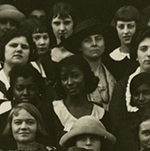 University Library
What She Said
University Library
What She Said
Part II: Women Together
Part III: Issue Spotlights
 University Library
What She Said
University Library
What She Said
Part II: Women Together
Part III: Issue Spotlights
During the 19th century, women's rights conventions took place across the Midwest and northeast. In great juxtaposition to the idealized story we often read today, the women's rights movement after the Civil War was messy, acrimonious, and sharply divided into groups that pursued wildly different strategies. These divisions were most immediately caused by the question of whether black men or white women should have priority in gaining voting rights. While some tried to argue the choice was false, the feminist-abolitionist coalition ultimately split into rival factions for several decades.
Disagreements about strategy were also rife. Susan B. Anthony and Elizabeth Cady Stanton favored prioritization of white women's enfranchisement, and advocated for a national strategy. Others supported a state-by-state approach, similar to the method adopted by Roe v. Wade opponents in recent years. In 1876, the centennial of the American Revolution, some suffragists took up the familiar "no taxation without representation" motto to argue in favor of woman suffrage, while free love advocates saw suffrage as a means of combating marriage, which they considered state-sanctioned prostitution.
Of these fractured efforts, the state-by-state approach was most effective despite its slow pace, especially in the west. Publications, pamphlets, broadsides, and ephemera documenting work at the state level include a poster made to inform first-time women voters how to vote in Massachusetts in 1895, and an invitation to attend a Michigan suffrage convention in 1889. Elements of the movement's contested origins can be seen in a postcard showing a church in Ohio, captioned as the site of the first woman's suffrage convention four years before Seneca Falls.
Case 3, Woman Suffrage Opponents, is to your right on the east wall of the gallery.
1
Postcard, Congregational Church in Jefferson, Ohio, site of the first Woman's Suffrage convention in 1844Women's Suffrage Collection
2
Invitation to attend the Fifth Annual Convention of the Michigan Equal Suffrage Association, 1889Women's Suffrage Collection
3
Bertha Rembaugh. The Political Status of Women in the United States: A Digest of the Laws Concerning Women in the Various States and Territories. New York: G. P. Putnam, 1911.JK 1889 R45 1911
4
Selina Solomons. How We Won the Vote in California. San Francisco: New Woman Publishing Company, 1911.JK 1911 C2 S6 1912
5
Broadside, "An Expert's Opinion: The Suffrage Question as Viewed by a Competent Michigan Woman," Issued by Michigan Woman's Christian Temperance Union Press BureauWomen's Suffrage Collection
6
Poster, "Instructions to Women Voters," Commonwealth of Massachusetts, 1895Women's Suffrage Collection
